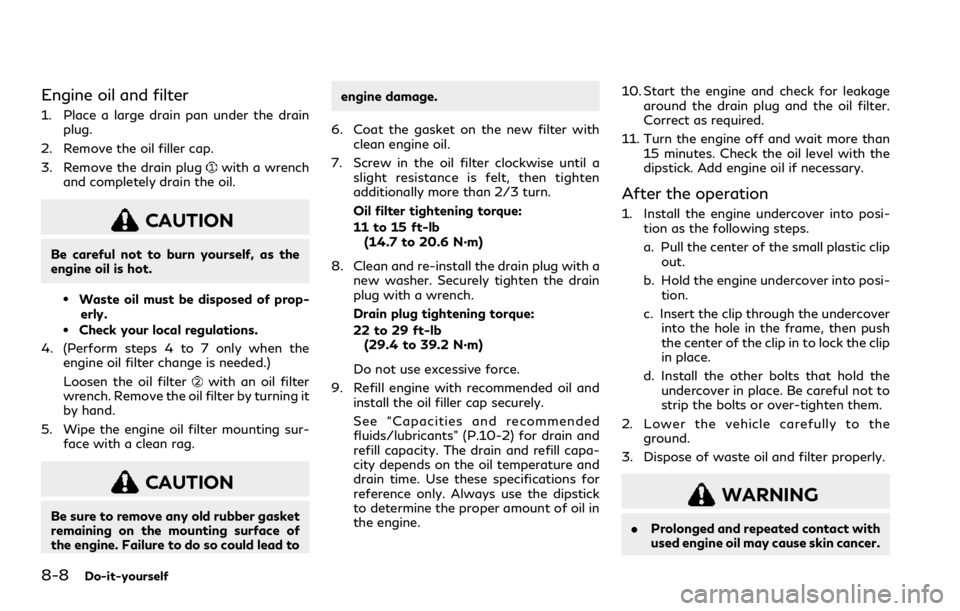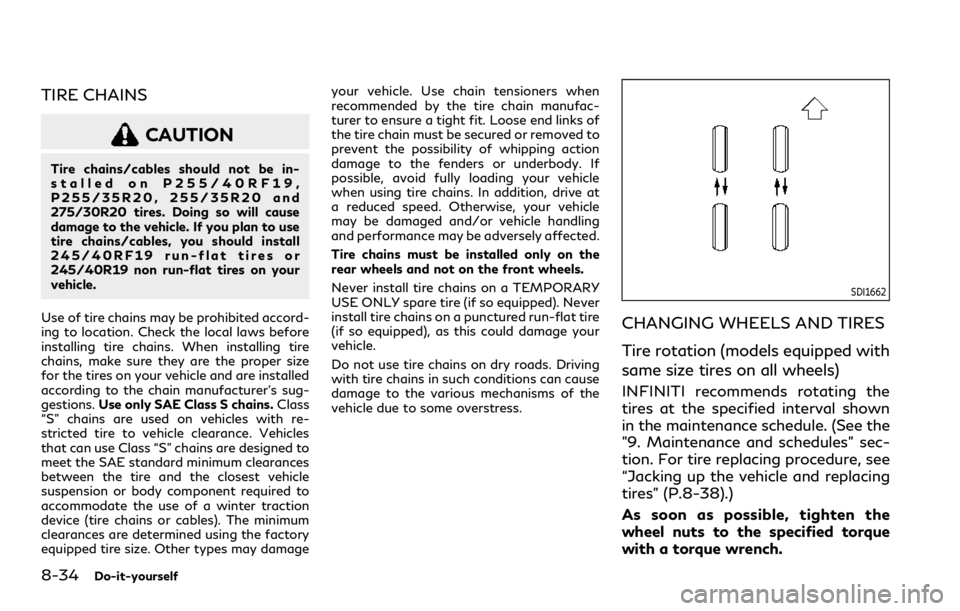torque INFINITI Q60 COUPE 2021 Owner's Manual
[x] Cancel search | Manufacturer: INFINITI, Model Year: 2021, Model line: Q60 COUPE, Model: INFINITI Q60 COUPE 2021Pages: 492, PDF Size: 2.44 MB
Page 249 of 492

JVS0251X
ACTIVE LANE CONTROL OP-
ERATION
Active Lane Control slightly corrects front
tire angles and steering wheel torque to help
reduce the difference between the vehicle’s
direction and the lane direction
which is
detected by using the camera unitlocated
above the inside mirror.
Active Lane Control operates under the
following conditions:
.When the vehicle is driven at speeds of
approximately 45 MPH (70 km/h) and
above.
.When the Lane Departure Prevention
(LDP) system is enabled in the settingsmenu on the lower display. To turn on
the LDP system, see “Lane Departure
Warning (LDW)/Lane Departure Pre-
vention (LDP)” (P.5-33).
.When Active Lane Control is enabled in
the settings menu on the display.
Starting and driving5-27
Page 398 of 492

8-8Do-it-yourself
Engine oil and filter
1. Place a large drain pan under the drain
plug.
2. Remove the oil filler cap.
3. Remove the drain plug
with a wrench
and completely drain the oil.
CAUTION
Be careful not to burn yourself, as the
engine oil is hot.
.Waste oil must be disposed of prop-
erly.
.Check your local regulations.
4. (Perform steps 4 to 7 only when the
engine oil filter change is needed.)
Loosen the oil filter
with an oil filter
wrench. Remove the oil filter by turning it
by hand.
5. Wipe the engine oil filter mounting sur-
face with a clean rag.
CAUTION
Be sure to remove any old rubber gasket
remaining on the mounting surface of
the engine. Failure to do so could lead toengine damage.
6. Coat the gasket on the new filter with
clean engine oil.
7. Screw in the oil filter clockwise until a
slight resistance is felt, then tighten
additionally more than 2/3 turn.
Oil filter tightening torque:
11 to 15 ft-lb
(14.7 to 20.6 N·m)
8. Clean and re-install the drain plug with a
new washer. Securely tighten the drain
plug with a wrench.
Drain plug tightening torque:
22 to 29 ft-lb
(29.4 to 39.2 N·m)
Do not use excessive force.
9. Refill engine with recommended oil and
install the oil filler cap securely.
See “Capacities and recommended
fluids/lubricants” (P.10-2) for drain and
refill capacity. The drain and refill capa-
city depends on the oil temperature and
drain time. Use these specifications for
reference only. Always use the dipstick
to determine the proper amount of oil in
the engine.10. Start the engine and check for leakage
around the drain plug and the oil filter.
Correct as required.
11. Turn the engine off and wait more than
15 minutes. Check the oil level with the
dipstick. Add engine oil if necessary.
After the operation
1. Install the engine undercover into posi-
tion as the following steps.
a. Pull the center of the small plastic clip
out.
b. Hold the engine undercover into posi-
tion.
c. Insert the clip through the undercover
into the hole in the frame, then push
the center of the clip in to lock the clip
in place.
d. Install the other bolts that hold the
undercover in place. Be careful not to
strip the bolts or over-tighten them.
2. Lower the vehicle carefully to the
ground.
3. Dispose of waste oil and filter properly.
WARNING
.Prolonged and repeated contact with
used engine oil may cause skin cancer.
Page 424 of 492

8-34Do-it-yourself
TIRE CHAINS
CAUTION
Tire chains/cables should not be in-
stalled on P255/40RF19,
P255/35R20, 255/35R20 and
275/30R20 tires. Doing so will cause
damage to the vehicle. If you plan to use
tire chains/cables, you should install
245/40RF19 run-flat tires or
245/40R19 non run-flat tires on your
vehicle.
Use of tire chains may be prohibited accord-
ing to location. Check the local laws before
installing tire chains. When installing tire
chains, make sure they are the proper size
for the tires on your vehicle and are installed
according to the chain manufacturer’s sug-
gestions.Use only SAE Class S chains.Class
“S” chains are used on vehicles with re-
stricted tire to vehicle clearance. Vehicles
that can use Class “S” chains are designed to
meet the SAE standard minimum clearances
between the tire and the closest vehicle
suspension or body component required to
accommodate the use of a winter traction
device (tire chains or cables). The minimum
clearances are determined using the factory
equipped tire size. Other types may damageyour vehicle. Use chain tensioners when
recommended by the tire chain manufac-
turer to ensure a tight fit. Loose end links of
the tire chain must be secured or removed to
prevent the possibility of whipping action
damage to the fenders or underbody. If
possible, avoid fully loading your vehicle
when using tire chains. In addition, drive at
a reduced speed. Otherwise, your vehicle
may be damaged and/or vehicle handling
and performance may be adversely affected.
Tire chains must be installed only on the
rear wheels and not on the front wheels.
Never install tire chains on a TEMPORARY
USE ONLY spare tire (if so equipped). Never
install tire chains on a punctured run-flat tire
(if so equipped), as this could damage your
vehicle.
Do not use tire chains on dry roads. Driving
with tire chains in such conditions can cause
damage to the various mechanisms of the
vehicle due to some overstress.
SDI1662
CHANGING WHEELS AND TIRES
Tire rotation (models equipped with
same size tires on all wheels)
INFINITI recommends rotating the
tires at the specified interval shown
in the maintenance schedule. (See the
"9. Maintenance and schedules" sec-
tion. For tire replacing procedure, see
“Jacking up the vehicle and replacing
tires” (P.8-38).)
As soon as possible, tighten the
wheel nuts to the specified torque
with a torque wrench.
Page 425 of 492

Wheel nut tightening torque:
80 ft-lb (108 N·m)
The wheel nuts must be kept tigh-
tened to the specification at all times.
It is recommended that wheel nuts be
tightened to the specification at each
tire rotation interval.
WARNING
.After rotating the tires, check
and adjust the tire pressure.
.Do not include the T-type spare
tire or any other small size
spare tire in the tire rotation.
.For additional information re-
garding tires, refer to “Impor-
tant Tire Safety Information”
(US) or “Tire Safety Informa-
tion” (Canada) in the Warranty
Information Booklet.
After the ignition switch is placed in
the ON position, it may take a period
of time for the tire pressure to be
displayed in the vehicle informationdisplay while the vehicle is driven.
Depending on the radio wave circum-
stance, tire pressure may not cor-
rectly be displayed.
Tire rotation (models equipped with
different size tires on front and rear)
Tires cannot be rotated on this vehi-
cle, as front tires are a different size
from rear tires.
A pin is on the front brake rotor to
prevent the rear wheels from being
installed in place of the front wheels.
The spare tire can be installed in place
of the front and rear wheels. When
installing the spare tire in the front
wheel, the hole in the spare tire wheel
must be aligned with the pin on the
brake rotor.
WARNING
.If your vehicle is equipped with
different size front and rear
tires, never install the rear
tire/wheel on the front of the
vehicle. Doing so can damagethe vehicle or tire. Damage to
the tire may result in a sudden
loss of air pressure which may
cause loss of vehicle control in
some driving conditions and
cause a collision and personal
injury.
.For additional information re-
garding tires, refer to “Impor-
tant Tire Safety Information”
(US) or “Tire Safety Informa-
tion” (Canada) in the Warranty
Information Booklet.
After the ignition switch is placed in
the ON position, it may take a period
of time for the tire pressure to be
displayed in the vehicle information
display while the vehicle is driven.
Depending on the radio wave circum-
stance, tire pressure may not cor-
rectly be displayed.
Do-it-yourself8-35
Page 430 of 492

8-40Do-it-yourself
SCE0504
2. Loosen each wheel nut one or two turns
by turning counterclockwise with the
wheel nut wrench.Do not remove the
wheel nuts until the tire is off the
ground.
3. Carefully raise the vehicle until the tire
clears the ground. To lift the vehicle,
securely hold the jack lever and rod with
both hands as shown above. Remove the
wheel nuts, and then remove the tire.
Installing a tire
1. Clean any mud or dirt from the surface
between the wheel and hub.
2. Carefully put the tire on and tighten the
wheel nuts finger tight.3. With the wheel nut wrench, tighten
wheel nuts alternately and evenly in the
sequence illustrated (
,,,,) until
they are tight.
4. Lower the vehicle slowly until the tire
touches the ground. Then, with the
wheel nut wrench, tighten the wheel
nuts securely in the sequence as illu-
strated. Lower the vehicle completely.
WARNING
.Incorrect wheel nuts or improperly
tightened wheel nuts can cause the
wheel to become loose or come off.This could cause an accident.
.Do not use oil or grease on the wheel
studs or nuts. This could cause the
nuts to become loose.
.As soon as possible, tighten the wheel
nuts to the specified torque with a
torque wrench.
Wheel nut tightening torque:
80 ft-lb (108 N·m)
The wheel nuts must be kept tigh-
tened to specification at all times. It
is recommended that wheel nuts be
tightened to specifications at each
lubrication interval.
.Adjust tire pressure to the COLD
pressure.
COLD pressure:
After the vehicle has been parked for
three hours or more or driven less
than 1 mile (1.6 km).
COLD tire pressures are shown on
the Tire and Loading Information
label affixed to the driver side center
pillar.
Securely store the jacking tools in the
vehicle.
Page 465 of 492

JVT0450X
Use the following steps to mount the license
plate.
Only use the recommended mounting posi-
tion, otherwise the radar sensor (Intelligent
Cruise Control (ICC) system) (if so equipped)
obstruction may result.
Before mounting the license plate, confirm
that the following parts are enclosed in the
plastic bag..License plate bracket
.J-nut × 2
.Screw × 2
1. Park the vehicle on flat, level ground.
2. Locate the two dimples
in the front
grille.
3. Insert J-nuts
into the license plate
bracket.
4. Insert the bosses of the license plate
bracket into the front grille, aligning the
holes
with the location marks (two
dimples).
5. Install the license plate bracket with the
screws
provided.
6. Install the license plate with bolts that
are no longer than 0.55 in (14 mm).JVT0455X
Left side
This vehicle is equipped with air deflectors in
front of the front wheels. The deflectors will
change the air flow to help improve aero-
dynamic performance.
When transporting your vehicle on a trailer,
the air deflectors may interfere with a steep
slope to a trailer bed. In this case, remove the
deflectors from the vehicle.
1. Loosen four screws as shown and re-
move the left-side air deflector
.
2. Tighten the removed screw
in its
original position.
Tightening torque:
4 to 6 ft-lb
(5.6 to 8.4 N·m)
Technical and consumer information10-15
INSTALLING FRONT LICENSE PLATEREMOVING AIR DEFLECTORS
Page 466 of 492

10-16Technical and consumer information
3. Perform the same procedure to remove
the right-side air deflector.
4. Store the two air deflectors and six
screws to reinstall in the reverse order.
5. When reinstalling, make sure all eight
screws are firmly tightened on both air
deflectors.
Tightening torque:
4 to 6 ft-lb
(5.6 to 8.4 N·m)
WARNING
.It is extremely dangerous to
ride in a cargo area inside the
vehicle. In a collision, people
riding in these areas are more
likely to be seriously injured or
killed.
.Do not allow people to ride in
any area of vehicle that is not
equipped with seats and seat
belts.
.Be sure everyone in your vehicle
is in a seat and using a seat belt
properly.
TERMS
It is important to familiarize yourself
with the following terms before load-
ing your vehicle:
.Curb Weight (actual weight of
your vehicle) - vehicle weight in-
cluding: standard and optional
equipment, fluids, emergency
tools, and spare tire assembly. This
weightdoes notinclude passen-gers and cargo.
.GVW (Gross Vehicle Weight) -
curb weight plus the combined
weight of passengers and cargo.
.GVWR (Gross Vehicle Weight Rat-
ing) - maximum total combined
weight of the unloaded vehicle,
passengers, luggage, hitch, trailer
tongue load and any other op-
tional equipment. This information
is located on the F.M.V.S.S./C.M.
V.S.S. label.
.GAWR (Gross Axle Weight Rating)
- maximum weight (load) limit
specified for the front or rear axle.
This information is located on the
F.M.V.S.S./C.M.V.S.S. label.
.GCWR (Gross Combined Weight
Rating) - The maximum total
weight rating of the vehicle, pas-
sengers, cargo, and trailer.
.Vehicle Capacity Weight, Load
limit, Total load capacity - max-
imum total weight limit specified
of the load (passengers and cargo)
for the vehicle. This is the max-
imum combined weight of occu-
VEHICLE LOADING INFORMATION